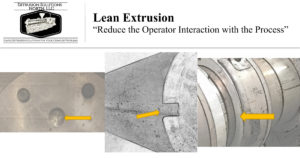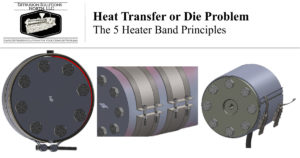Is Your Extrusion Die Flow Changing Despite Following All the Correct Formulas?
Is starting up with a Dry Die the Problem?
One of the most common problems extrusion plants have is: flow shifting in the die tooling, especially after starting up. Even when the past run history and set up documents are followed and painstakingly reviewed for something that was missed in error. What should be a quick change-over turns into the dreaded scrap nightmare. What went wrong?
Going back in history, sharing knowledge in tool building was taboo. Each tool maker had their little notebook of cheat notes on land ratios and what draw-down to use with each material. In the end each tool made from any given tool shop was different. Fast forward and shops are run differently, with most shops running towards one common standard. More literature on tool design is available than in the past, so what is causing the flow shift? Let’s problem solve and look at the steps which may be causing the flow shift.
*Pressure: Back pressure is usually monitored and recorded in most extrusion shops but is seldom manipulated to optimize the process. When a new tool is tuned the pressure is recorded as a standard and not questioned if it is correct. Many articles have been written on the effects of low head pressure to a lack of screw performance in a single screw extruder. What we are looking for in pressure as it pertains to flow shift in the die, is consistency. A consistent pressure should always be presented to the die for stability.
*Melt Temp: this article is not to ascertain what the proper melt temperature should be, much like pressure, the melt temperature should always be presented to the die in the same consistent temperature for stability.
*Die Land: If the die land ratio is not sufficient the lowered residence time along with a lack of backpressure will create flow shift and instabilities. Many shops tend to start out light on the land ratio and do not have sufficient land for stability after the land is reduced in the development process. Be steel safe and error on the extra land side. As an added benefit land reduces the swell of the material as it exits the die. Most material call for 15:1 land ratio or greater.
*Heater Bands: In a past article, I wrote about the five heater band principles as being one of the most overlooked variables of the extrusion process. Let’s assume you have read the article and corrected any deficient principles of the five and heat to the die is correct and consistent. At this point you may want to go back and read that article and do a double check on the heater bands.
Ok, so what if the Pressure, Melt Temp, Die Land and Heater Bands all check out, but the dreaded flow shift happens anyway. There is one more thing to do, which many times will stop flow shift, lubricate the tooling. The cavity of a streamline plate does not fill equally being the channel lengths are different, with varying lengths of drag flow. The bigger the tool the larger the cavity to fill and the greater the potential for problems. Lubricate all components of the tooling while hung on the extruder, before starting up. The Initial pressure will be reduced but will increase and reach a stabilization point. Many times, the improved drag flow will eliminate the flow shift issue.



